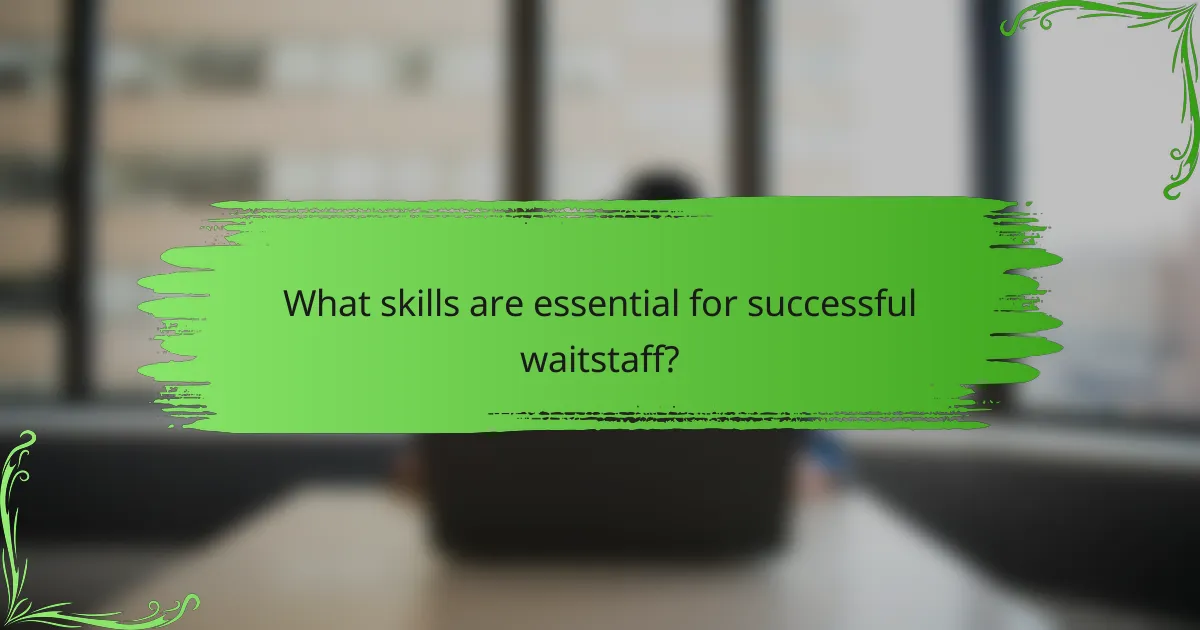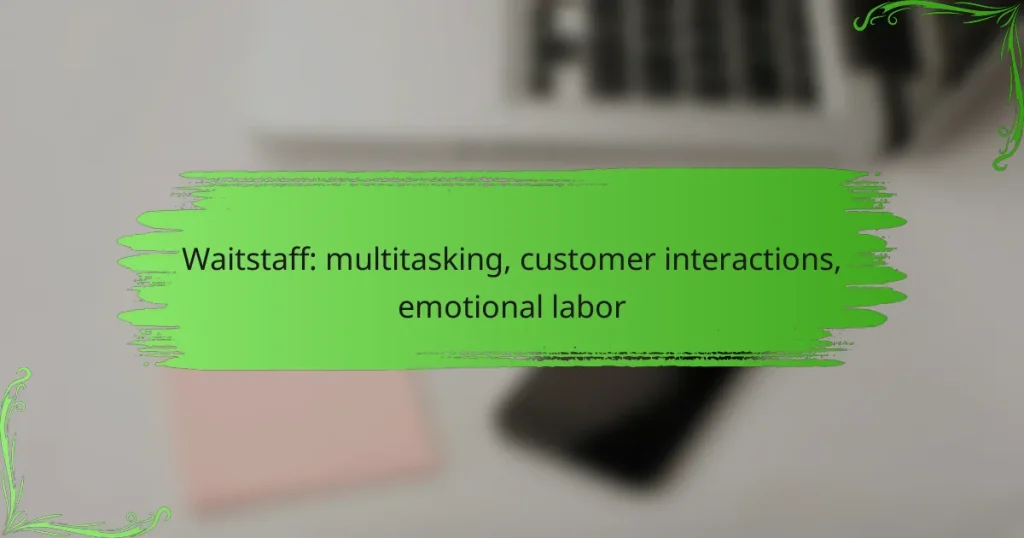Waitstaff play a crucial role in the dining experience by expertly multitasking in fast-paced environments while prioritizing customer needs. Through effective communication and attentiveness, they enhance interactions and build customer loyalty. However, the emotional labor involved in maintaining a positive demeanor can lead to stress and fatigue, highlighting the complexities of their role.

How do waitstaff effectively multitask in busy environments?
Waitstaff effectively multitask in busy environments by prioritizing customer needs, utilizing technology, managing their time efficiently, and undergoing specialized training. These strategies help them handle multiple tasks simultaneously while maintaining high service standards.
Prioritizing tasks based on customer needs
To prioritize tasks, waitstaff must assess the immediate needs of their customers. This often means addressing requests from tables with larger groups or those who have been waiting longer. By focusing on the most pressing needs, they can enhance customer satisfaction and streamline service.
Effective communication is key; waitstaff should regularly check in with customers to gauge their needs. This can help in deciding whether to serve drinks, take food orders, or clear tables first, ensuring that no customer feels neglected.
Utilizing technology for order management
Technology plays a crucial role in helping waitstaff manage orders efficiently. Many restaurants use point-of-sale (POS) systems that allow staff to input orders directly from the table, reducing errors and speeding up service. Mobile devices can also facilitate communication between the kitchen and waitstaff, ensuring timely updates on order status.
Using apps for table management can help waitstaff keep track of which tables need attention and which orders are pending. This organized approach minimizes confusion and allows for smoother multitasking during peak hours.
Implementing time management techniques
Effective time management is essential for waitstaff in busy environments. Techniques such as setting specific time limits for tasks can help maintain a steady workflow. For instance, aiming to serve drinks within a few minutes of taking an order can enhance overall efficiency.
Creating a mental checklist of tasks can also aid in prioritizing actions. By quickly assessing what needs to be done next, waitstaff can avoid delays and ensure that all customers receive prompt service.
Training for efficiency under pressure
Training programs focused on efficiency can significantly improve waitstaff performance in high-pressure situations. Role-playing scenarios that simulate busy shifts can prepare staff for real-life challenges, helping them learn to think on their feet and manage stress effectively.
Regular training sessions can also reinforce best practices for multitasking, such as how to balance multiple tables and prioritize customer interactions. This ongoing education fosters a culture of excellence and adaptability among staff, which is vital in fast-paced environments.

What are best practices for customer interactions?
Best practices for customer interactions involve effective communication, attentiveness, and a personalized approach. These strategies enhance the overall dining experience and foster customer loyalty.
Active listening to enhance service
Active listening is crucial for waitstaff to understand customer needs and preferences. This involves giving full attention to the guest, acknowledging their requests, and responding appropriately. For instance, repeating back orders or confirming dietary restrictions can prevent misunderstandings.
To practice active listening, maintain eye contact, nod in acknowledgment, and refrain from interrupting. This not only shows respect but also encourages guests to share more about their preferences, leading to better service.
Personalizing experiences for guests
Personalizing guest experiences can significantly enhance customer satisfaction. This can be achieved by remembering repeat customers’ names, favorite dishes, or special occasions. Simple gestures, like offering a complimentary dessert for a birthday, can leave a lasting impression.
Consider using a guest management system to track preferences and past interactions. This allows waitstaff to tailor their service, making guests feel valued and recognized, which can lead to increased tips and repeat visits.
Handling complaints with empathy
Handling complaints effectively requires empathy and a calm demeanor. When a guest expresses dissatisfaction, acknowledge their feelings and apologize sincerely. This can diffuse tension and show that you care about their experience.
After acknowledging the issue, offer a solution or alternative. For example, if a dish is unsatisfactory, suggest a replacement or provide a discount. Ensuring that the guest feels heard and valued can turn a negative experience into a positive one, encouraging them to return.

How does emotional labor impact waitstaff?
Emotional labor significantly affects waitstaff by requiring them to manage their emotions while interacting with customers. This can lead to stress and fatigue as they strive to maintain a positive demeanor, even in challenging situations.
Understanding emotional labor in service roles
Emotional labor in service roles involves the management of feelings and expressions to fulfill the emotional requirements of a job. For waitstaff, this means projecting friendliness and attentiveness, regardless of their personal feelings. This can create a disconnect between their true emotions and the persona they present to customers.
In many cases, waitstaff must suppress negative emotions and amplify positive ones, which can be mentally taxing. This ongoing effort can lead to emotional dissonance, where the staff feels one way but must act another, potentially impacting their job satisfaction and overall well-being.
Strategies for managing emotional exhaustion
To combat emotional exhaustion, waitstaff can implement several strategies. One effective approach is to take regular breaks during shifts to recharge mentally and physically. Even short moments away from customer interactions can help alleviate stress.
Additionally, practicing mindfulness techniques, such as deep breathing or visualization, can help staff manage their emotions more effectively. Creating a supportive work environment where team members can share experiences and challenges can also reduce feelings of isolation and stress.
Recognizing signs of burnout in waitstaff
Burnout in waitstaff can manifest through various signs, including chronic fatigue, irritability, and decreased job performance. Staff may also experience a sense of detachment from their work or customers, which can affect service quality.
It’s crucial for waitstaff to be aware of these signs and take proactive steps to address them. Regular self-assessments and open communication with management about workload and emotional challenges can help identify burnout early, allowing for timely interventions and support.

What skills are essential for successful waitstaff?
Successful waitstaff must possess a blend of communication, problem-solving, and teamwork skills to provide excellent service. These abilities help them navigate customer interactions, manage high-pressure situations, and collaborate effectively with kitchen staff.
Communication skills for effective service
Effective communication is crucial for waitstaff to understand customer needs and convey orders accurately to the kitchen. This includes active listening, clear speaking, and the ability to read non-verbal cues from guests.
Using friendly and approachable language can enhance the dining experience. For instance, greeting customers warmly and checking in on their satisfaction throughout the meal fosters a positive atmosphere.
Problem-solving abilities in high-pressure situations
Waitstaff often face unexpected challenges, such as order mix-ups or customer complaints. Strong problem-solving skills enable them to address these issues swiftly and efficiently, ensuring minimal disruption to service.
For example, if a dish is unavailable, a waitstaff member should quickly suggest alternatives and reassure the customer. Staying calm under pressure and thinking on their feet can significantly improve customer satisfaction.
Teamwork and collaboration with kitchen staff
Collaboration with kitchen staff is essential for waitstaff to ensure smooth service. This involves clear communication about orders, dietary restrictions, and special requests to avoid misunderstandings.
Building a good rapport with kitchen personnel can lead to better service outcomes. Regularly checking in with the kitchen during busy times helps maintain a steady flow of orders and enhances overall efficiency.

How can waitstaff improve tips and customer satisfaction?
Waitstaff can enhance tips and customer satisfaction by focusing on personalized service, effective communication, and timely interactions. Building strong relationships with patrons and providing attentive service can lead to increased gratuities and repeat visits.
Building rapport with regular customers
Establishing a connection with regular customers is crucial for enhancing their dining experience. Remembering names, favorite dishes, and preferences can make patrons feel valued and appreciated. Simple gestures, like greeting them warmly or asking about their day, can foster loyalty.
Consider keeping a mental note or a small record of regulars’ preferences to personalize their experience further. This attention to detail can lead to higher tips and more frequent visits.
Offering menu recommendations and upselling
Providing thoughtful menu recommendations can significantly impact customer satisfaction and tips. Familiarize yourself with the menu, including specials and popular items, to confidently suggest dishes that align with customers’ tastes.
Upselling, when done tactfully, can enhance the dining experience. For instance, recommending a wine pairing or a dessert can elevate the meal and increase the overall bill, benefiting both the customer and your tip. Aim for a balance; avoid being overly pushy, as this can deter customers.
Ensuring timely service and follow-ups
Timeliness is a key factor in customer satisfaction. Strive to serve food and drinks promptly, ideally within single-digit minutes after ordering. Regularly check in with customers to ensure they have everything they need without being intrusive.
Follow-ups after serving the main course can also enhance the experience. Asking if everything is satisfactory or if they need anything else shows attentiveness and can lead to positive feedback and increased tips. Aim to create a seamless flow of service that keeps customers engaged and satisfied throughout their meal.

What training programs are available for waitstaff?
Training programs for waitstaff typically focus on customer service skills, menu knowledge, and operational procedures. These programs can vary from formal courses to on-the-job training, depending on the establishment’s requirements.
Formal training programs
Formal training programs for waitstaff often include courses offered by culinary schools or hospitality management programs. These courses cover essential topics such as food safety, customer service techniques, and effective communication skills. Graduates may receive certifications that enhance their employability in the restaurant industry.
On-the-job training
On-the-job training is a common approach where new waitstaff learn directly from experienced employees. This method allows trainees to gain practical experience in real-time, understanding the specific dynamics of their workplace. It often includes shadowing, role-playing customer interactions, and gradually taking on more responsibilities.
Online training resources
Online training resources have become increasingly popular, offering flexibility for waitstaff to learn at their own pace. These resources can include video tutorials, interactive courses, and quizzes that cover various aspects of waitstaff duties. Many platforms also provide certifications upon completion, which can be beneficial for career advancement.
Workshops and seminars
Workshops and seminars are often organized by industry associations or local restaurants to provide targeted training on specific skills. These events can focus on topics like wine pairing, upselling techniques, or handling difficult customers. Participating in such workshops can enhance a waitstaff member’s skills and knowledge, making them more valuable to their employer.


